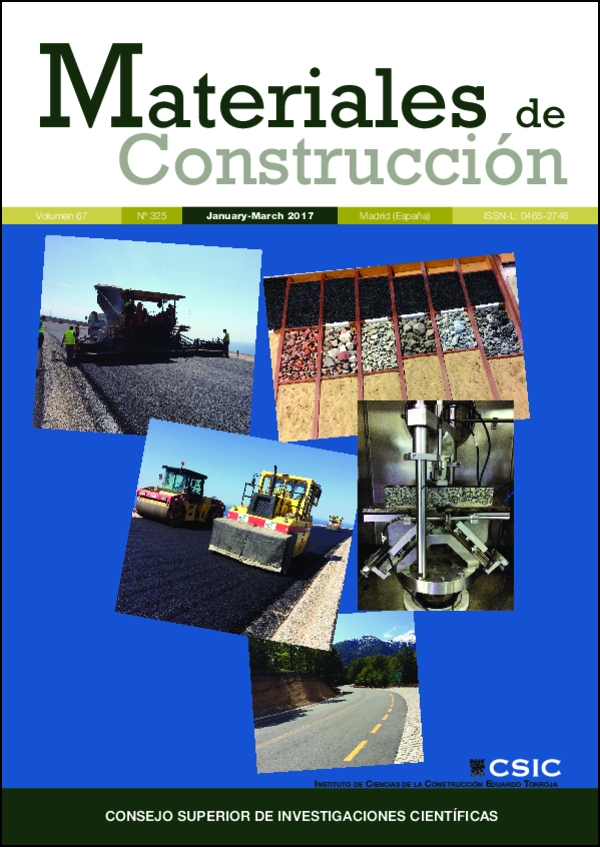Portland blended cements: demolition ceramic waste management
DOI:
https://doi.org/10.3989/mc.2017.00516Keywords:
Portland cement, Demolition ceramic waste, Pozzolane, CharacterizationAbstract
Demolition ceramic wastes (DCWs) were investigated in order to determine their potential use as supplementary cementitious materials in Portland Blended Cements (PBCs). For this purpose, three ceramic wastes were investigated. After characterization of the materials used, the effect of ceramic waste replacement (8, 24 and 40% by mass) was analyzed. Pozzolanic activity, hydration progress, workability and compressive strength were determined at 2, 7 and 28 days. The results showed that the ground wastes behave as filler at an early age, but as hydration progresses, the pozzolanic activity of ceramic waste contributes to the strength requirement.
Downloads
References
Schneider, M.; Romer, M.; Tschudin, M.; Bolio, H. (2011) Sustainable cement production: present and future. Cem. Concr. Res. 41, 642–650.
ASTM C618-12a: Standard Specification for Fly Ash and Raw or Calcined Natural Pozzolan for use as a Mineral Admixture in Portland Cement Concrete.
Tironi, A.; Trezza, M.A.; Scian, A.; Irassar, E.F. (2012) Kaolinitic calcined clays: Factors affecting its performance as pozzolans. Con. Build. Mat. 28 [1], 276–281. https://doi.org/10.1016/j.conbuildmat.2011.08.064
Tironi, A.; Trezza, M.A.; Scian, A.N.; Irassar, E.F. (2013) Assessment of pozzolanic activity of different calcined clays. Cem. Concr. Compos. 37, 319–327.
Zimbili, O.; Salim W.; Ndambuki, M. (2014) A review on the usage of ceramic wastes in concrete production. Int. J. Civil, Enviromental, Structural, Construction & Architectural Engineering 8 [1] 91–95.
Andres Juan; César Medina; Julia, M. Morán; M. Ignacio, Guerra; Pedro, J. Aguado; Mª Isabel Sanchez, De Rojas; Moisés Frías; Olga Rodriguez, 2010. Re-Use of Ceramic Wastes in Construction, Ceramic Materials, Wilfried Wunderlich (Ed.), ISBN: 978-953-307-145-9, InTech, http://www.intechopen.com/books/ceramic-materials/re-use-of-ceramic-wastes-in-construction.
Yuan, H.; Shen, L. (2011) Trend of the research on construction and demolition waste management. Waste Manage. 31, 670–679. https://doi.org/10.1016/j.wasman.2010.10.030 PMid:21169008
Rozas, F.; Castillo, A.; Martínez, I.; Castellote, M. (2015) Guidelines for assessing the valorization of a waste into cementitious material: dredged sediment for production of self compacting concrete. Mater. Construcc. 65 [319], 1–13.
Poon, C.S. (2007) Reducing construction waste, editorial. Waste Manage. 27 [12], 1715–1716. https://doi.org/10.1016/j.wasman.2007.08.013 PMid:17904489
Pereira-de-Oliveira, L.A.; Castro-Gomes, J.P.; Santos, P.M.S. (2012) The potential pozzolanic activity of glass and red-clay ceramic waste as cement mortars components. Con. Build. Mat. 31, 197–203.
Sánchez de Rojas, M.I.; Marin, F.; Rivera, J.; Frias, M. (2006) Morphology and properties in blended cements with ceramic wastes as a pozzolanic material. J. Am. Ceram. Soc. 89 [12], 3701–3705. https://doi.org/10.1111/j.1551-2916.2006.01279.x
Sánchez de Rojas, M.I.; Marin, F.P.; Frías, M.; Rivera, J. (2007) Properties and performances of concrete tiles containing waste fired clay materials. J. Am. Ceram. Soc. 90 [11], 3559–3565. https://doi.org/10.1111/j.1551-2916.2007.01944.x
Puertas, F.; Garcia-Diaz, I.; Barba, A.; Gazulla, M.F.; Palacios, M.; Gomez, M.P. (2008) Ceramic wastes as alternative raw materials for Portland cement clinker production. Cem. Concr. Compos. 30 [9] 798–805. https://doi.org/10.1016/j.cemconcomp.2008.06.003
Lavat, A.E.; Trezza, M.A.; Poggi, M. (2009) Characterization of ceramic roof tile wastes as pozzolanic admixture. Waste Manage. 29 [5], 1666–1674. https://doi.org/10.1016/j.wasman.2008.10.019 PMid:19124234
Bignozzi, M.C.; Bondua, S. (2011) Alternative blended cement with ceramic residues: corrosion resistance investigation on reinforced mortar. Cem. Concr. Res. 41[9], 947–954. https://doi.org/10.1016/j.cemconres.2011.05.001
Naceri, A.; Hamina, M.C. (2009) Use of waste brick as a partial replacement of cement in mortar. Waste Manage. 29 [8], 2378–2384. https://doi.org/10.1016/j.wasman.2009.03.026 PMid:19383569
Lin, K.L.; Chen, B.Y.; Chiou, C.S.; Cheng, A. (2010) Waste brick's potential for use as a pozzolan in blended Portland cement. Waste Manage. Res. 28 [7], 647–652. https://doi.org/10.1177/0734242X09355853 PMid:20103570
Lin, K.L.; Wu, H.H.; Shie, J.L.; Hwang, C.L.; Cheng, A. (2010) Recycling waste brick from construction and demolition of buildings as pozzolanic materials. Waste Manage. Res. 28, 653–659.
Binici, H.; Kapur, S.; Arocena, J.; Kaplan, H. (2013) The sulphate resistance of cements containing red brick dust and ground basaltic pumice with sub-microscopic evidence of intra-pore gypsum and ettringite as strengtheners. Cem. Concr. Compos. 34 [2], 279–287.
Ay, N.; Unal, M. (2000) The use of waste ceramic tile in cement production. Cem. Concr. Res. 30 [3], 497–499. https://doi.org/10.1016/S0008-8846(00)00202-7
IRAM 50000: Cement. Cement for general use. Composition, characteristics, conformity assessment and reception (in Spanish).
EN 197-1:2011. Ordinary cements: composition, specifications and conformance criteria (in Spanish).
ASTM C204-11. Standard test methods for fineness of hydraulic cement by air-permeability apparatus.
EN 196-5: Cements Test Methods: Pozzolanic test for Pozzolanic cements (in Spanish).
ASTM C1437-15, Standard Test Method for Flow of Hydraulic Cement Mortar-
Chakchouk, A.; Trifi, L.; Samet, B.; Bouaziz, S. (2009) Formulation of blended cement: Effect of process variables on clay pozzolanic activity. Con. Build. Mat. 23 [3], 1365 – 1373. https://doi.org/10.1016/j.conbuildmat.2008.07.015
Bensted, J.; Varna, S.P. (1977) Infrared and Raman spectroscopy in cement chemistry-miscellaneous applications World Cem. Technol. 8 [1] 16–20.
Zhang, C.; Wan, A.; Tang, M.; Liu, X. (1996) The filling role of pozzolanic materials. Cem. Concr. Res. 26 [6], 943–947. https://doi.org/10.1016/0008-8846(96)00064-6
Toledo Filho, R.D.; Gonçalves, J.P.; Americano, B.B.; Fairbairn, E.M.R. (2007) Potential for use of crushed waste calcined-clay brick as a supplementary cementitious material in Brazil. Cem. Concr. Res. 37[9], 1357–1365. https://doi.org/10.1016/j.cemconres.2007.06.005
WRI (2005) Navigating the Numbers: Greenhouse Gas Data and International Climate Policy. World Resources Institute, 74. http://pdf.wri.org/navigating_numbers.pdf
http://www.actualizarmiweb.com/sites/afcp/publico/ P201504/estadistica.htm.
Published
How to Cite
Issue
Section
License
Copyright (c) 2017 Consejo Superior de Investigaciones Científicas (CSIC)

This work is licensed under a Creative Commons Attribution 4.0 International License.
© CSIC. Manuscripts published in both the print and online versions of this journal are the property of the Consejo Superior de Investigaciones Científicas, and quoting this source is a requirement for any partial or full reproduction.
All contents of this electronic edition, except where otherwise noted, are distributed under a Creative Commons Attribution 4.0 International (CC BY 4.0) licence. You may read the basic information and the legal text of the licence. The indication of the CC BY 4.0 licence must be expressly stated in this way when necessary.
Self-archiving in repositories, personal webpages or similar, of any version other than the final version of the work produced by the publisher, is not allowed.
















